Themed collection Functional Coordination Networks

The terpyridine isomer game: from chelate to coordination network building block
Recent progress towards a better understanding of the design principles associated with the use of 4,2′:6′,4′′-tpy, 3,2′:6′,3′′-tpy, bis(4,2′:6′,4′′-tpy) and bis(3,2′:6′,3′′-tpy) linkers and nodes in coordination networks is presented.
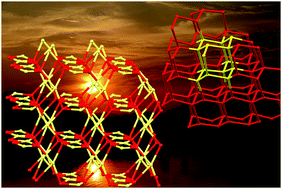
Chem. Commun., 2020,56, 10786-10794
https://doi.org/10.1039/D0CC04477F
Design and properties of multiple-emitter luminescent metal–organic frameworks
This feature article reviews the design strategies by which multiple different emission sources could be combined for creating multi-emitter luminescent metal–organic frameworks (LMOFs).
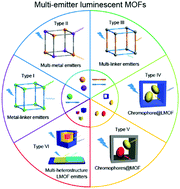
Chem. Commun., 2020,56, 12290-12306
https://doi.org/10.1039/D0CC04733C
Metal phosphonates incorporating metalloligands: assembly, structures and properties
This feature article summarizes the current status of metal–metalloligand phosphonates including the synthetic strategies, crystal structures and properties. Future challenges in this field are discussed.
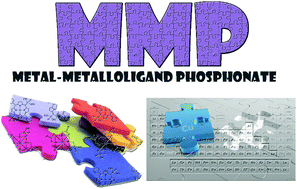
Chem. Commun., 2020,56, 12090-12108
https://doi.org/10.1039/D0CC03850D
Metal–organic framework (MOF) materials as polymerization catalysts: a review and recent advances
Metal–organic frameworks are versatile materials that provide new opportunities as catalysts in polymerization reactions, including modularity and well-defined structures.
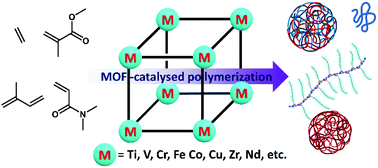
Chem. Commun., 2020,56, 10409-10418
https://doi.org/10.1039/D0CC03790G
Crystal engineering of porous coordination networks to enable separation of C2 hydrocarbons
Diverse crystal engineering principles employed in the discovery of porous coordination networks for the selective separation of C2 gases reveal that control of pore size and pore chemistry emerges as the key to unlock their outstanding performances.
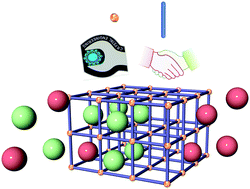
Chem. Commun., 2020,56, 10419-10441
https://doi.org/10.1039/D0CC04645K
One-dimensional electronic systems: metal-chain complexes and organic conductors
This feature article highlights and compares the structural and physical properties of typical examples of one-dimensional metal-chain complexes and organic conductors.

Chem. Commun., 2020,56, 10100-10112
https://doi.org/10.1039/D0CC04124F
Porous materials as carriers of gasotransmitters towards gas biology and therapeutic applications
This review highlights the strategies employed to load and release gasotransmitters such as NO, CO and H2S from different kinds of porous materials, including zeolites, mesoporous silica, metal–organic frameworks and protein assemblies.
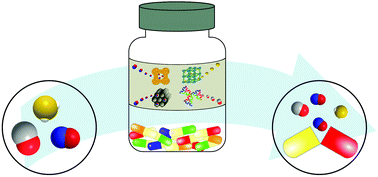
Chem. Commun., 2020,56, 9750-9766
https://doi.org/10.1039/D0CC03740K
Pillared cobalt metal–organic frameworks act as chromatic polarizers
The anisotropic alignment of chromophores in a cobalt-based metal–organic framework produces a dichromatic dichroic effect, showing a range of colors from blue to yellow depending on the orientation of polarized light relative to the crystal.
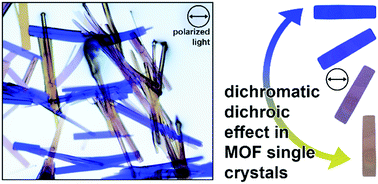
Chem. Commun., 2021,57, 1022-1025
https://doi.org/10.1039/D0CC07316D
Enhanced proton conductivity in a flexible metal–organic framework promoted by single-crystal-to-single-crystal transformation
Transformation of MFM-722(Pb)-DMA to MFM-722(Pb)-H2O leads to an increase in proton conductivity linked to a structural transition.
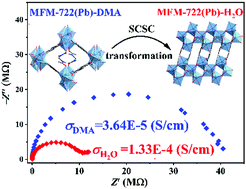
Chem. Commun., 2021,57, 65-68
https://doi.org/10.1039/D0CC05270A
A metal–organic framework supported iridium catalyst for the gas phase hydrogenation of ethylene
Gas phase hydrogenation of ethylene by a MOF supported Iridium catalyst highlights the role of support and counteranion effects.
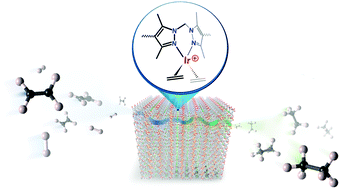
Chem. Commun., 2020,56, 15313-15316
https://doi.org/10.1039/D0CC06058E
S-Mg2(dobpdc): a metal–organic framework for determining chirality in amino acids
Solid-state 13C NMR was used to differentiate the D- and L-enantiomers of three BOC-protected amino acids (Ala, Val, Pro) when appended to the chiral S-Mg2dobpdc MOF.
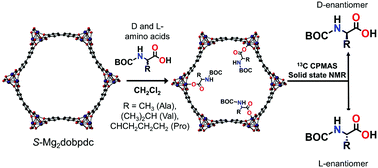
Chem. Commun., 2020,56, 14829-14832
https://doi.org/10.1039/D0CC05539E
Nickel(II)-modified covalent-organic framework film for electrocatalytic oxidation of 5-hydroxymethylfurfural (HMF)
Nickel(II)-modified covalent-organic framework (COF) film exhibited electrocatalytic oxidation of 5-hydroxymethylfurfural (HMF) with ∼96% conversion.
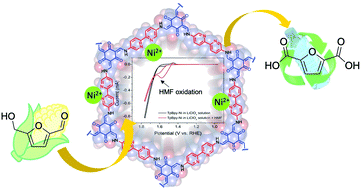
Chem. Commun., 2020,56, 14361-14364
https://doi.org/10.1039/D0CC02206C
Unravelling a long-lived ligand-to-metal cluster charge transfer state in Ce–TCPP metal organic frameworks
We report the ultrafast charge separation dynamics in porphyrin-based Ce–TCPP MOFs using optical and X-ray transient absorption (XTA) spectroscopy.
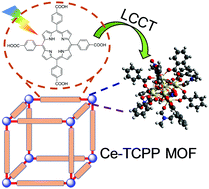
Chem. Commun., 2020,56, 13971-13974
https://doi.org/10.1039/D0CC04116E
Mixed donor, phenanthroline photoactive MOFs with favourable CO2 selectivity
Mixed donor phenanthroline-carboxylate linkers were combined with MnII or ZnII to form photoactive MOFs with large pore apertures.
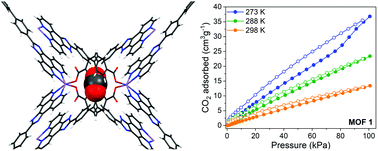
Chem. Commun., 2020,56, 13377-13380
https://doi.org/10.1039/D0CC05715K
Preliminary chemical reduction for synthesizing a stable porous molecular conductor with neutral metal nodes
Preliminary chemical reduction of naphthalenediimide (NDI)-based organic ligands was applied to the synthesis of a porous molecular conductor (PMC) with neutral metal nodes (cobalt(II) acetylacetonate).
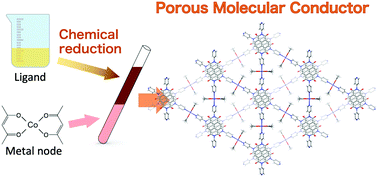
Chem. Commun., 2020,56, 13109-13112
https://doi.org/10.1039/D0CC03541F
Fatty acids as biomimetic replication agents for luminescent metal–organic framework patterns
Insoluble fatty acids that trigger the growth of luminescent MOFs on fingerprint residues were employed for the precise positioning of MOFs.

Chem. Commun., 2020,56, 12733-12736
https://doi.org/10.1039/D0CC03876H
Second-order programming the synthesis of metal–organic frameworks
The first example of ‘one-pot’ coordinate-covalent synthetic programming for metal–organic frameworks is reported.
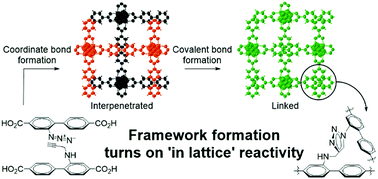
Chem. Commun., 2020,56, 12355-12358
https://doi.org/10.1039/D0CC05451H
Rotational dynamics of the imidazolium ion in cyanide-bridged dielectric framework materials
Quasielastic neutron scattering reveals the geometry and timescale of the dielectric switching dynamics in a series of elpasolite-like framework materials.
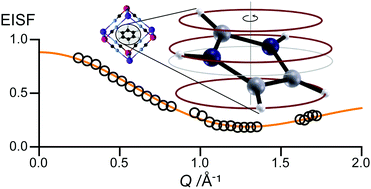
Chem. Commun., 2020,56, 11791-11794
https://doi.org/10.1039/D0CC05238H
Heterometal incorporation in NH2-MIL-125(Ti) and its participation in the photoinduced charge-separated excited state
X-ray spectroscopy studies reveal the location and role of Fe3+ sites incorporated in a Ti-based MOF exhibiting photo-induced charge separation.

Chem. Commun., 2020,56, 11597-11600
https://doi.org/10.1039/D0CC05339B
Fine tuning of intra-lattice electron transfers through site doping in tetraoxolene-bridged iron honeycomb layers
The precise tuning of the multiple electron transfers based on a chemical technique of site-doping in tetraoxolene-bridged Fe honeycomb layer systems was demonstrated.
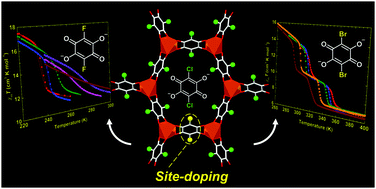
Chem. Commun., 2020,56, 10867-10870
https://doi.org/10.1039/D0CC03808C
Spin crossover modulation in a coordination polymer with the redox-active bis-pyridyltetrathiafulvalene (py2TTF) ligand
A 1-D chain CP with both SCO and redox activity has been successfully prepared by the combination of a bis-pyridyl functionalised TTF core and a Schiff base-like N2O2 ligand.
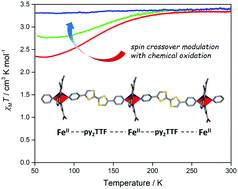
Chem. Commun., 2020,56, 10469-10472
https://doi.org/10.1039/D0CC03788E
Structure-directing role of immobilized polyoxometalates in the synthesis of porphyrinic Zr-based metal–organic frameworks
We report the templating effect of the PW12 polyoxometalate on the porphyrinic MOF topologies whereby the kinetic phase is favored at high temperature.
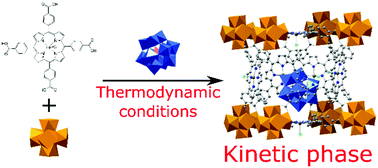
Chem. Commun., 2020,56, 10143-10146
https://doi.org/10.1039/D0CC04283H
N,N-Diethyl-3-methylbenzamide (DEET) acts as a metal–organic framework synthesis solvent with phase-directing capabilities
A variety of metal–organic frameworks typically synthesized in formamide solvents are produced in the insect repellent N,N-diethyl-3-methylbenzamide producing controlled-release composites.
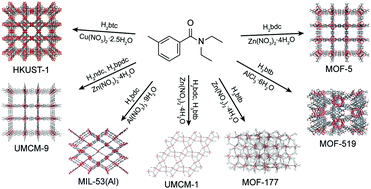
Chem. Commun., 2020,56, 9966-9969
https://doi.org/10.1039/D0CC02741C
Slow relaxation of the magnetization, reversible solvent exchange and luminescence in 2D anilato-based frameworks
Reversible solvent exchange in three Dy(III)-bromanilato 2D frameworks with solvent dependent luminescence and slow relaxation of the magnetization.
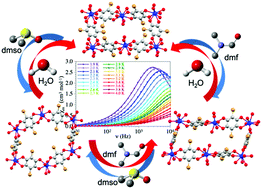
Chem. Commun., 2020,56, 9862-9865
https://doi.org/10.1039/D0CC03964K
Control of local flexibility towards p-xylene sieving in Hofmann-type porous coordination polymers
Tuning of local flexibility towards p-xylene achieved by the control of the specific combination of coordination metal centers in Hofmann-type porous coordination polymers.
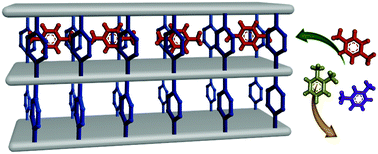
Chem. Commun., 2020,56, 9632-9635
https://doi.org/10.1039/D0CC03854G
Topology versus porosity: what can reticular chemistry tell us about free space in metal–organic frameworks?
We analyse 3D coordination networks in 33 790 coordination polymers and discuss relations between their topological and porosity properties.
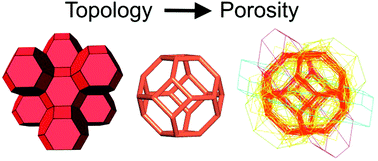
Chem. Commun., 2020,56, 9616-9619
https://doi.org/10.1039/D0CC04004E
Unravelling the water adsorption in a robust iron carboxylate metal–organic framework
Scale-up of an Fe-MOF and elucidation of its water adsorption properties by PXRD, sorption measurements and molecular simulations are reported.
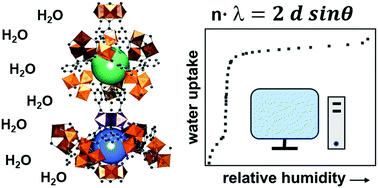
Chem. Commun., 2020,56, 9628-9631
https://doi.org/10.1039/D0CC03489D
Coordination distortion induced water adsorption in hydrophobic flexible metal–organic frameworks
The water-adsorption properties of four isostructural hydrophobic metal-organic frameworks are dependent on the metal species, which was revealed to be caused by coordination distortion around the metal ions.

Chem. Commun., 2020,56, 9106-9109
https://doi.org/10.1039/D0CC03772A
Highly stable 3D porous HMOF with enhanced catalysis and fine color regulation by the combination of d- and p-ions when compared with those of its monometallic MOFs
Three comparable MOFs were yielded successfully. Among them, the highly stable HMOF is a porous 3D motif with lots of active sites, leading to the enhanced catalysis for CO2 conversion and fine color regulations of MOFs by doping different ions.
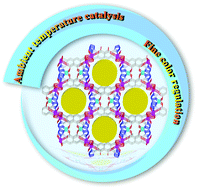
Chem. Commun., 2020,56, 8758-8761
https://doi.org/10.1039/D0CC03111A
Emergence of electrical conductivity in a flexible coordination polymer by using chemical reduction
Postsynthetic chemical reduction enhanced the electrical conductivity of a new flexible 1D coordination network with a naphthalenediimide (NDI)-based ligand.
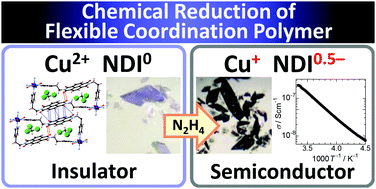
Chem. Commun., 2020,56, 8619-8622
https://doi.org/10.1039/D0CC03062G
Pore space partition of a fragile Ag(I)-carboxylate framework via post-synthetic linker insertion
Pore space partitioning via post-synthetic insertion of dipyridyl linkers with different lengths modulates the porosity of Ag(I)-based MOFs.
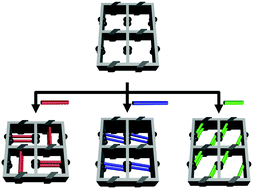
Chem. Commun., 2020,56, 8615-8618
https://doi.org/10.1039/D0CC03472J
Filling vacancies in a Prussian blue analogue using mechanochemical post-synthetic modification
Mechanochemical grinding offers a method of reducing the vacancy concentration of Prussian blue analogues.
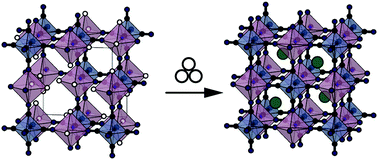
Chem. Commun., 2020,56, 7873-7876
https://doi.org/10.1039/D0CC02922J
The force of MOFs: the potential of switchable metal–organic frameworks as solvent stimulated actuators
The force exerted by flexible metal–organic framework through expansion was experimentally evaluated for MIL-53(Al).

Chem. Commun., 2020,56, 7411-7414
https://doi.org/10.1039/D0CC02505D
Salt nanoconfinement in zirconium-based metal–organic frameworks leads to pore-size and loading-dependent ionic conductivity enhancement
Confinement of the salt [NEt4][TFSI] in metal–organic frameworks leads to a significant enhancement in ionic conductivity, pointing toward a novel method of creating solid ion conductors.
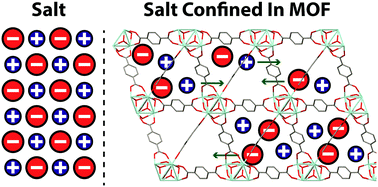
Chem. Commun., 2020,56, 7245-7248
https://doi.org/10.1039/D0CC03147J
Rotation of a helical coordination polymer by mechanical grinding
Mechanical grinding causes anisotropic cell volume expansion, which facilitates the misaligned arms containing olefin functional groups in the neighbouring strands of the photo-inert helical coordination polymer to align to undergo [2+2] cycloaddition reaction.
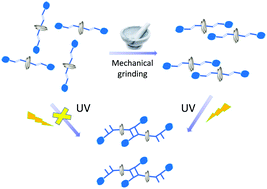
Chem. Commun., 2020,56, 6289-6292
https://doi.org/10.1039/D0CC02158J
Organic “receptor” fully covered few-layer organic–metal chalcogenides for high-performance chemiresistive gas sensing at room temperature
2D organic–metal chalcogenides (OMCs) were developed as a new type of material for high-performance RT gas sensing.
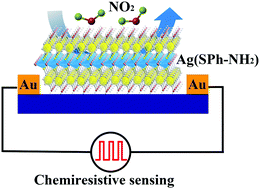
Chem. Commun., 2020,56, 5366-5369
https://doi.org/10.1039/D0CC01092H
Reactivity of borohydride incorporated in coordination polymers toward carbon dioxide
Borohydride-containing coordination polymers convert CO2 into formate or formylhydroborate depending on their crystal structures.
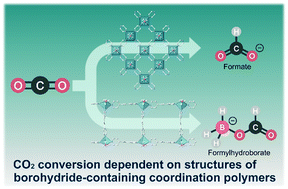
Chem. Commun., 2020,56, 5111-5114
https://doi.org/10.1039/D0CC01753A
Interfacial engineering of a polymer–MOF composite by in situ vitrification
In situ vitrification of MOF within polymer can rigidify the polymer chains and remove interfacial defects, leading to a significantly enhanced membrane selectivity.

Chem. Commun., 2020,56, 3609-3612
https://doi.org/10.1039/D0CC00664E